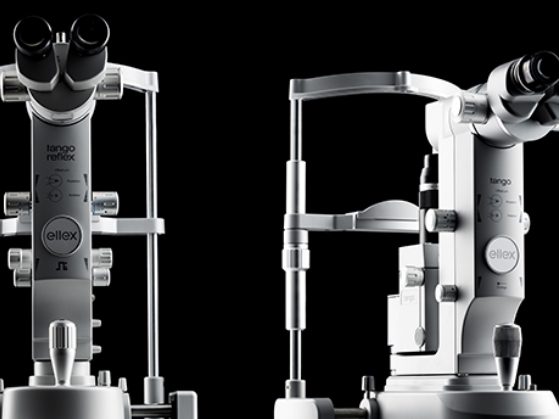Selective Laser Trabeculoplasty, or SLT, is a form of laser surgery that is used to lower intraocular pressure in glaucoma. It is used when eye drop medications are not lowering the eye pressure enough or are causing significant side effects. It can also be used as initial treatment in glaucoma. SLT has been in use for more than 25 years but recent advances in laser technology have resulted in greater use of laser treatment, often avoiding the need for more invasive surgery or extra glaucoma drops. Please view the SLT video at www.tanner-eyes.co.uk which further explains the procedure.
The Ultra Q Reflex and Tango Reflex systems provide treatment flexibility and will ensure that you can achieve the results you and your patients are looking for — every time.

Selective laser trabeculoplasty (SLT)

Selective laser trabeculoplasty (SLT)

Ellex Selective Laser Trabeculoplasty (SLT) Animation
Patients who have primary or secondary open-angle glaucoma (the drainage system in the front part of the eye is open) and need to have lower intraocular pressure (IOP).
Laser energy is applied to the drainage tissue in front of the eye (the trabecular meshwork). This starts a chemical and biological change that results in better drainage of fluid through the trabecular meshwork and out of the eye. This eventually results in lowering of pressure. It may take 1-3 months for the full treatment effect to appear. It is important to remember that this procedure is performed to save the sight you still have. It will not restore any sight you may have already lost, or improve your sight. SLT is successful in about three out of four (75%) patients.
The type of laser used is only taken up by selected pigmented tissue in the eye. Sometimes it is referred to as a “cold laser.” Because of this, the procedure produces less scar tissue and has minimal pain. This gentle laser treatment induces white cells to be released which clean and rebuild the meshwork. This allows the drainage meshwork to function more effectively, reducing the pressure.
SLT has a very good safety profile, even when compared with glaucoma drops. Post-operative inflammation is common but generally mild, and treated with steroid eye drops. There is an approximately 5% incidence of pressure elevation after laser, managed by glaucoma drops and usually resolved after 24 hours. Rarely, the pressure in the eye rises to a very high pressure and does not come down. If this happens, you might require surgery to lower the pressure. However, this is a very unusual occurrence.
SLT lowers the IOP by about 30% when used as initial therapy. This is comparable to the pressure lowering effect of the most powerful and commonly used glaucoma drops. This effect may be reduced if you are already on glaucoma medications. The effect will generally last between 1-5 years or sometimes longer.
If SLT is effective at lowering IOP but then wears off after several years, the procedure can be repeated. About half of patients will require repeat treatment after 5 years. Repeat treatments don’t always lower IOP as much, and continued repeat laser will eventually not be effective. In some patients we may decide to treat half of the tissue on the first treatment, then treat the second half at a later date. If SLT is not initially successful, repeat treatment is not likely to be effective.
Laser energy is applied to the drainage tissue in front of the eye (the trabecular meshwork). This starts a chemical and biological change that results in better drainage of fluid through the trabecular meshwork and out of the eye. This eventually results in lowering of pressure. It may take 1-3 months for the full treatment effect to appear. It is important to remember that this procedure is performed to save the sight you still have. It will not restore any sight you may have already lost, or improve your sight. SLT is successful in about three out of four (75%) patients.
If SLT fails to lower the IOP, then the glaucoma is treated by other means such as medications or surgery. The laser does not affect the success of these other types of treatment.
Some patients can be controlled with just laser treatment. Others require additional IOP lowering and may therefore need to use glaucoma medication as well. Think of SLT as equivalent to one glaucoma medication. Just as some patients will require more than one glaucoma medication, some may also require laser plus one or more glaucoma medications. It is important to remember that SLT is not a cure for glaucoma, just as medication and surgery are not cures either.
Other similar procedures are argon laser trabeculoplasty (ALT) and micropulse laser trabeculoplasty (MLT). ALT was the first laser trabeculoplasty procedure. It uses a thermal (heat) laser and may cause more scarring in the drainage angle than SLT. MLT was designed to reduce the amount of energy delivered to ocular tissues by pulsing the energy in small increments. It therefore has similar potential benefits as SLT in terms of lower inflammation, tissue scarring and ability to repeat. The IOP lowering results of SLT, ALT and MLT are comparable.
You will need to visit the outpatient department for approx. 2 hours. We will carry out the treatment in the laser treatment room. A nurse will check your vision and insert some anaesthetic drops together with a drop to prevent a post laser pressure rise. It is important that you use your regular eye medication as normal on the day of your laser treatment. We also usually put in a drop to make the pupil smaller – this may give you an ache around the eye or a headache. Please let us know if you would like a paracetamol to help ease any discomfort. You will then sit at a machine similar to the one used to examine your eyes at the eye clinic, but with a special laser attached to it. Mr Tanner will put a special contact lens on your eye before applying the laser beam. This lens allows a clear view and helps apply the laser to the drainage channels. During the laser treatment, you might see some flashes of light and hear clicking noises. Most patients tolerate the laser treatment well, but some might feel slight discomfort. The treatment is painless due to the anaesthetic drops used to numb your eye beforehand. It takes about 10 minutes per eye to complete.
You will return to the waiting area and have a pressure check about one hour later. Your vision may be a little blurred and you may be dazzled by the bright light but this should settle within about 10 minutes. This may occasionally be due to your cornea (the clear window in the front of your eye) swelling, which is usually temporary but may require treatment with steroid drops for a few extra days. You will be prescribed steroid eye drops to control inflammation. You must continue to use your usual glaucoma eye drops to the treated eye. If you are using glaucoma drops to the untreated eye, please also continue to use them. You should be able to return to work and your usual activities by the next day.
Disclaimer : The information provided in this website is intended as a useful aid to general practitioners, optometrists and patients. It is impossible to diagnose and treat patients adequately without a thorough eye examination by a qualified ophthalmologist, optometrist or your general practitioner. Hopefully the information will be of use prior to and following a consultation which it supplements and does not replace.


